
Ameiva, commonly called jungle-runners, is a genus of whiptail lizards that belongs to the family Teiidae.

Nereocystis is a monotypic genus of subtidal kelp containing the species Nereocystis luetkeana. Some English names include edible kelp, bull kelp, bullwhip kelp, ribbon kelp, bladder wrack, and variations of these names. Due to the English name, bull kelp can be confused with southern bull kelps, which are found in the Southern Hemisphere. Nereocystis luetkeana forms thick beds on subtidal rocks, and is an important part of kelp forests.
Arthrostylidium is a Neotropical genus of climbing bamboo in the grass family. the species are native to Central America, the West Indies, northern South America, and southern Mexico.

Knecht Ruprecht is a companion of Saint Nicholas as described in the folklore of Germany. He first appears in written sources in the 17th century, as a figure in a Nuremberg Christmas procession.

Postelsia palmaeformis, also known as the sea palm or palm seaweed, is a species of kelp and classified within brown algae. The sea palm is found along the western coast of North America, on rocky shores with constant waves. It is one of the few algae that can survive and remain erect out of the water; in fact, it spends most of its life cycle exposed to the air. It is an annual, and edible, though harvesting of the alga is discouraged due to the species' sensitivity to overharvesting.
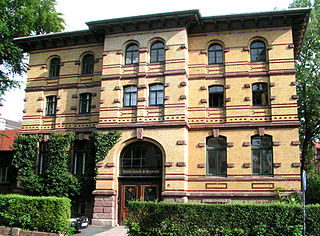
Vandenhoeck & Ruprecht (V&R) is a scholarly publishing house based in Göttingen, Germany. It was founded in 1735 by Abraham Vandenhoeck (1700-1750) in connection with the establishment of the Georg-August-Universität in the same city.
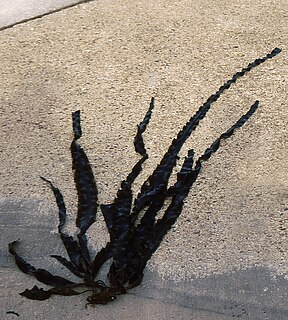
Saccharina is a genus of 24 species of Phaeophyceae. It is found in the north Atlantic Ocean and the northern Pacific Ocean at depths from 8 m to 30 m.

Franz Josef Ruprecht was an Austrian-born physician and botanist active in the Russian Empire, where he was known as Frants Ivanovič Ruprekht.

Turbinaria is a genus of brown algae (Phaeophyceae) found primarily in tropical marine waters. It generally grows on rocky substrates. In tropical Turbinaria species that are often preferentially consumed by herbivorous fishes and echinoids, there is a relatively low level of phenolics and tannins.

Adiantum pedatum, the northern maidenhair fern or five-fingered fern, is a species of fern in the family Pteridaceae, native to moist forests in eastern North America. Like other ferns in the genus, the name maidenhair refers to the slender, shining black stipes.

Corallina is a genus of red seaweeds with hard, abrasive calcareous skeletons in the family Corallinaceae. They are stiff, branched plants with articulations.
Pterygophora californica is a large species of kelp, commonly known as stalked kelp. It is the only species in its genus Pterygophora. It grows in shallow water on the Pacific coast of North America where it forms part of a biodiverse community in a "kelp forest". It is sometimes also referred to as woody-stemmed kelp, walking kelp, or winged kelp.
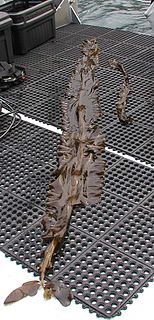
Alaria marginata, the winged kelp, is a brown alga species in the genus Alaria. It can grow up to 13 feet. Fronds are long and narrow with raised midrib and wavy edges. Each frond has two rows of several smooth, oblong, 5 inch spore-bearing blades at the base in winter. The base is attached to rocks.
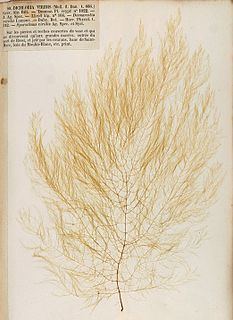
Desmarestia is a genus of brown algae found worldwide. It is also called acid weed, acidweed, oseille de mer, sea sorrel, ウルシグサ, stacheltang, mermaid's hair, landlady's wig, or gruagach. However, 'sea sorrel' can also specifically refer to Desmarestia viridis. Members of this genus can be either annual or perennial. Annual members of this genus store sulfuric acid in intracellular vacuoles. When exposed to air they release the acid, thereby destroying themselves and nearby seaweeds in the process. They are found in shallow intertidal zones.

Diphasiastrum sitchense, the Sitka clubmoss, is a pteridophyte species native to northern North America and northeastern Asia. It is a terrestrial herb spreading by stolons running on the surface or the ground or just slightly below the surface. Leaves are appressed, broadly lanceolate, up to 3.2 mm long. Strobili are solitary on the ends of shoots. It is known from every province in Canada, plus the US States of Alaska, Oregon, Washington, Idaho, Montana, Maine, New Hampshire, Vermont, and New York. It is also found in Greenland, St. Pierre and Miquelon, Yukon, Japan, and the Kamchatka Peninsula of Asiatic Russia. It can be found in alpine meadows, open rocky barrens, and coniferous woodlands.
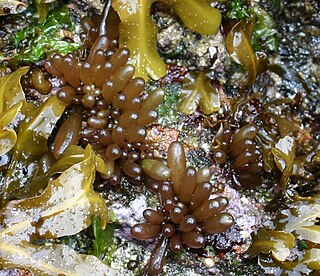
Halosaccion glandiforme, also known as sea sacs or sea grapes, is a species of red algae.
Lychnothamnus is a genus of stoneworts belonging to the family Characeae.
Dumontia is a genus of red algae belonging to the family Dumontiaceae.
Delesseria is a genus of algae belonging to the family Delesseriaceae.
Gloiopeltis is a genus of red algae belonging to the family Endocladiaceae.













